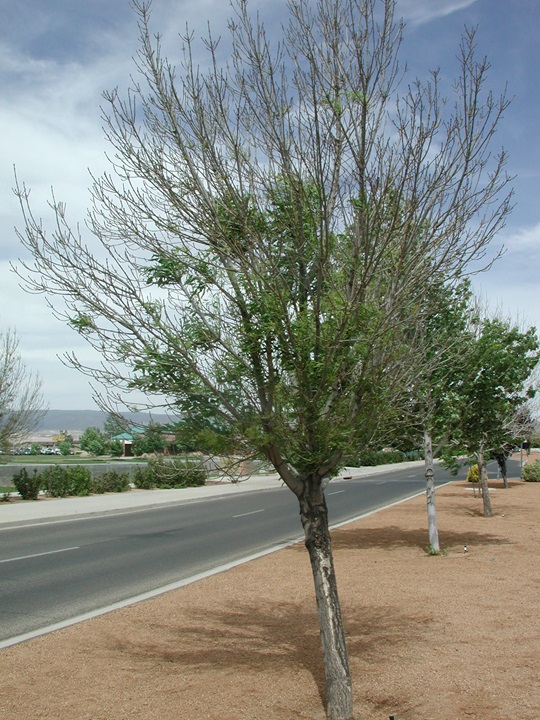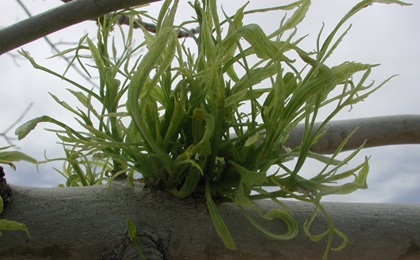 Ash Decline - May 30, 2018 Jeff Schalau, Agent, Agriculture & Natural Resources University of Arizona Cooperative Extension, Yavapai County In the summer of 2009, I was called by municipal landscape professionals to look at some ash trees with unusual symptoms in Prescott Valley. That same summer, ash trees in Chino Valley and Cottonwood displayed similar symptoms. On the sites with symptomatic trees, multiple trees were affected, but some of the adjacent ash trees were growing normally and had no symptoms. The aforementioned symptoms include: ash trees with dead and dying branches; affected trees had some new foliage trying to emerge from buds lower on the branches, but this new foliage was greatly reduced in size and never attained the size of normal ash tree foliage (these tufts of foliage are called “witches brooms”); the two or three year’s previous growth rates on affected trees were greatly reduced as indicated by bud scars (2-4 inches of new growth rather than a foot or more); and in one case, an ash had tree died. Species known to be affected are Arizona ash (Fraxinus velutina) and Modesto ash (F. velutina ‘Modesto’). Raywood ash (F. oxycarpa) may also be affected. Arizona ash is native to Yavapai County and the other two are the primary ash species planted here. My first thought was an abiotic (environmental/non-living) cause since the problem was present in several trees but no apparent connection could be seen – many affected ash trees were growing next to unaffected ash trees. Upon seeing the symptoms, my first inclination was chemical injury because of the stunted, misshapen leaves. However, all involved assured me that no herbicides or other chemicals had been used near the trees. Once multiple reports were made and I talked at length with other tree owners and ruled out chemical injury. In 2009, University of Arizona Cooperative Extension Plant Pathologist, Dr. Mary Olsen, and Forest Health Specialist, Arizona State Forestry Division, Bob Celaya and I went to the field and investigated several of the affected trees. Putting our heads together, we were not able to definitively diagnose the cause of decline in the affected ash trees. Our recommendations were to flood the irrigation basins (the trees were on drip systems). Strangely enough, many of the Prescott Valley trees have recovered and the dead material has been pruned out. A few have since died and been replaced. I write about this malady now because we may start seeing these symptoms on ash again this year. I comfortable with diagnosing the condition as “ash yellows” also known as “ash decline” (different names for the same condition). Ash decline (AD) is caused by a phytoplasma, a bacterium that lives in the phloem (tissue that conducts the products of photosynthesis) and is transmitted (vectored) by phloem feeding insects such as leaf hoppers, spittlebugs, and psyllids. The AD pathogen is difficult to work with because it cannot be kept alive outside the plant in culture and diagnosis is done using molecular analysis. Some plant pathologists think that plant tissue used to produce grafted ash trees sold by nurseries may have been infected by the pathogen. Once an infected tree is fed upon by a suitable insect vector, it can transmit the disease to uninfected trees. The AD pathogen has been confirmed in Arizona (see additional references below). Treatments for AD are not effective and it is recommended that seriously stunted trees be removed. However, until we confirm the disease, removal may not be warranted. I suppose the problem could have another cause, such as plant parasitic nematodes, but I tend to think that AD is the cause. Meanwhile, keep an eye out for symptoms of AD on your ash trees. If you notice the symptoms, inspect the irrigation system to make sure its functioning properly. If a tree seems under-irrigated, periodically irrigate the tree using a soaker hose or flooding a basin that extends outward from the trunk to the drip line of the canopy. This will ensure the problem is not caused by insufficient irrigation. I hope that we can have a definitive diagnosis of AD, but until then, we’ll have to live with it and provide the best care possible for our ash trees. Follow the Backyard Gardener on Twitter – use the link on the BYG website. If you have other gardening questions, call the Master Gardener help line in the Camp Verde office at 928-554-8992 or e-mail us at verdevalleymg@gmail.com and be sure to include your name, address and phone number. Find past Backyard Gardener columns or provide feedback at the Backyard Gardener web site: http://cals.arizona.edu/yavapai/anr/hort/byg/. Photos  Ash decline symptoms on Modesto ash (Fraxinus velutina 'Modesto') growing in Prescott Valley, AZ (Jeff Schalau).
Ash decline symptoms on Modesto ash (Fraxinus velutina 'Modesto') growing in Prescott Valley, AZ (Jeff Schalau). Close-up of witches broom symptoms of ash decline on Modesto ash (Fraxinus velutina 'Modesto') growing in Prescott Valley, AZ (Jeff Schalau).
Close-up of witches broom symptoms of ash decline on Modesto ash (Fraxinus velutina 'Modesto') growing in Prescott Valley, AZ (Jeff Schalau).Additional Resources Host Range and Distribution of the Phytoplasma Causing Arizona Ash Decline (Journal of Arboriculture) http://joa.isa-arbor.com/request.asp?JournalID=1&ArticleID=202&Type=2 Ash Yellows (University of Wisconsin Extension) hort.uwex.edu/articles/ash-yellows/ Ash Yellows (University of Illinois Extension) http://urbanext.illinois.edu/hortanswers/detailproblem.cfm?PathogenID=85 |